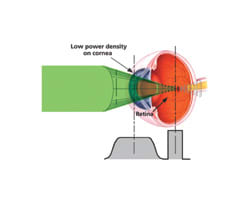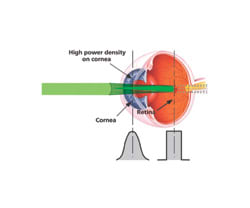An All-Inclusive Laser: the Multicolor
Novus Varia
Dependable,
quiet, and versatile, the Novus Varia is in constant demand.
BY DAVID R. CHOW, MD, FRCSC
The fundamental concept underlying the use of lasers in retinal surgery is relatively simple: deliver enough laser energy to the target tissues to achieve the desired goal. There are literally hundreds of lasers on the market that can accomplish this objective with more or less equal efficacy. What differentiates one laser from the next are the relevant ancillary factors — ease of use, dependability, convenience, and versatility.
I have operated many of the lasers on the market today and consider the Novus Varia (Lumenis, Santa Clara, Calif) to be the gold standard, as no other laser provides the surgeon with so many advantageous features in a single product. Approved by the Food and Drug Administration (FDA) in 2002, the Novus Varia is the only photocoagulator that combines a diode-pumped semiconductor laser with the ability to emit multicolor beams (red, green, and yellow).
|
|
|
|
Figure 1a. The SureSpot
Optical System's focused laser beam provides uniform energy distribution at all
spot sizes, maintaining lower power density at the cornea. |
|
|
|
|
|
Figure 1b. A standard parfocal optical system allows the convergence angle of the beam to change at larger spot sizes, so that the cornea may be exposed to potentially harmful power densities. |
RELIABILITY AND CONVENIENCE
Most of my experience with this laser was acquired at a busy practice that employed 10 retinal specialists, 6 of us working in 1 office. We began to employ the device right around the time it was approved, and because its standard applications are so wide-ranging, it was used often. The Novus Varia proved useful in diabetic macular edema, proliferative diabetic retinopathy, vascular occlusions (branch vein or central vein), choroidal neovascularization, and retinal tears — all of the classic retinal/laser applications. In retrospect, what strikes me as remarkable now is that in 2 years of almost constant use, the Novus Varia has neither failed to perform nor required servicing. Having never experienced a laser with such an extraordinary track record, I would list dependability among the top reasons for recommending it. For a high-volume retinal practice, dependability is of major importance. If you have ever been forced to reschedule a whole day's worth of patients when an error code arises and the machine refuses to reboot right after the morning's very first procedure, you understand my meaning.
Unlike some of the older model lasers, the Novus Varia runs quietly and does not generate excessive heat. Again, this may sound trivial if you only use a laser once a week, but for a high-volume retinal practice, less noise and cooler running make a big difference to both surgeon and patient. The reason this device generates less heat is that the diode pump converts a higher percentage of its electrical requirements into the visible laser light, around 50%, compared to sometimes less than 10% in the older diode lasers. Another energy convenience is that this laser can be plugged into a standard wall socket. There is no need to call an electrician for a 220-volt upgrade every time you want to move the laser to a different location. Additionally, the extremely small footprint and weight allows for additional flexibility in moving the equipment.
The Novus Varia also possesses the unique and patented SureSpot Optics system to increase safety. The focused beam offers uniform distribution of the laser energy and maintains a lower power density at the cornea throughout the procedure, compared to the potentially damaging levels of power that are delivered to the cornea with standard systems (Figures 1a and b).
THREE-COLOR DIODE LASER
Diode lasers are available in smaller, more portable instruments, but none offers 3-color capability. Theoretically, one can argue that 3-color capability is a beneficial clinical option. The traditional theory is that laser power delivered to the retina is taken up primarily by 1 of 3 pigments: melanin, hemoglobin, or xanthophyll. The energy will be taken up by 1, 2, or all of these pigments depending on the wavelength of the laser employed (Figure 2). The theoretic advantages of using a yellow wavelength is that this wavelength approximates the peak absorption of hemoglobin allowing more selective laser energy delivery to vascular target tissues such as a microaneurysm in cases of diabetic macular edema or retinal venous occlusions. I often find that with yellow, I use lower powers and pulse durations than I would with a similar green system. Red, on the other hand, penetrates through media opacities more effectively to create a deeper burn, which is preferable for some pathologies such as certain tumors. However, in fairness, it should be noted that clinical studies have yet to confirm whether different wavelengths produce better outcomes in these circumstances. For example, while most retinal surgeons believe yellow is a better choice for microaneurysms, many other practitioners have used only the green wavelengths for decades and have not encountered problems.
|
|
|
|
|
Figure 2. The wavelength absorption of green, yellow, and red in ocular tissue. |
I believe the 3-color options to be a clinical advantage. If I am performing a panretinal photocoagulation on a diabetic retina, I usually begin the procedure with a green wavelength. Should I encounter a little blood along the way, I may switch to the red wavelength to ensure better penetration through the blood layer. Again, the Novus Varia scores high marks for convenience during the switch from 1 wavelength to another. It takes less than 5 seconds to switch wavelengths, while in older instruments this process was considerably longer. Changes are easily made on the touch-screen display or the remote, and instant feedback is achieved with the display changing to the color of the desired wavelength. The touch-screen software interface is easy to use and intuitive, clearly demonstrating the color, power, and duration being used.
FLEXIBILITY FOR BETTER PROCEDURES
Another convenient feature is the dual-fiber system, which can accommodate 2 delivery devices and allows me to switch from slit lamp to a laser indirect ophthalmoscope. For instance, while treating a patient with a retinal tear, I may start off at the slit lamp only to realize I cannot reach far enough into the periphery with the contact lens on. In that case, I can simply pull aside the slit lamp, press a button, put on the indirect, and finish the rest of the procedure. With other instruments, such a move would entail ample fiddling to hook up the indirect by changing the laser fiber into the laser port.
The clear filter is not unique to this laser system, but it is the best one I have encountered thus far. This filter optimizes transmission of viewing light while delivering the beam. However, there still is a significant difference between the view with the filter and without, and I suspect there is room for improvement in this technology. Five years from now, we may be able to obtain better visualization while still protecting the surgeon's eyesight.
Finally, the additional foot pedals that are available as an option on the Novus Varia enhance the flexibility of this laser. Most lasers have 1 pedal that activates the beam. The Novus Varia can be equipped with 2 extra pedals: 1 to activate the clear filter and 1 that can be kicked left or right to adjust the power of the beam. If a patient is being treated and the clinician notices that the burns are becoming too chalky white (an indication of excessive power), the pedal can be kicked to the left, dropping the power by 20 mW. On the other hand, if the beam is too weak, the pedal can be kicked to the right, achieving the opposite effect. In models without these pedals, the surgeon can still adjust power levels from the direct touch screen or the portable touch pad that rests on the lap, but this involves taking one's hands off the instrument and eyes off the target for a few seconds. These aforementioned pedals are so popular that I have noticed other laser manufacturers following suit and adding them to their machines.
The Novus Varia combines several features in 1 laser, providing a tremendous advantage to the busy surgeon and making it my diode laser of choice.
Until recently, David R. Chow was an assistant professor of ophthalmology at Rush Medical College and a surgeon at Illinois Retinal Associates. He is in the process of transferring to a position at the University of Toronto. Dr. Chow has no financial interest in Lumenis or the Novus Varia. He can be reached at davidrchow@mac.com.











